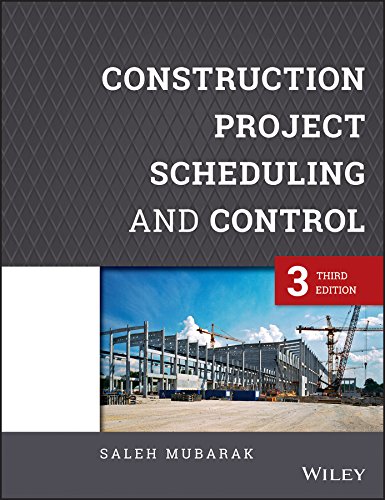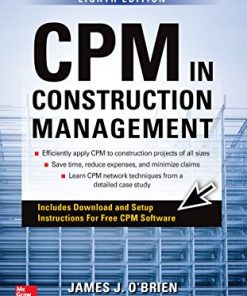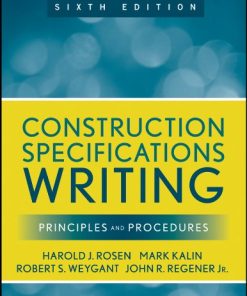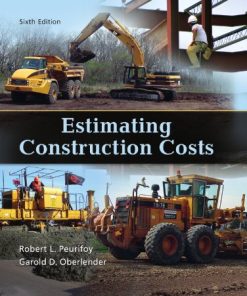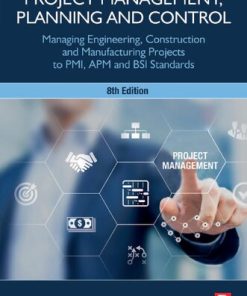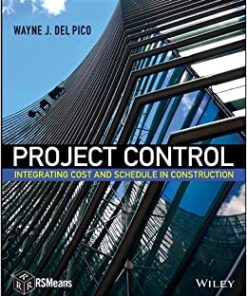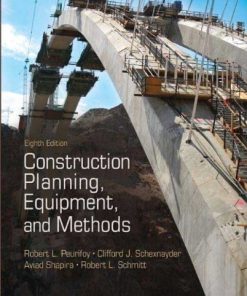Construction Project Scheduling and Control – Ebook PDF Version
$50.00 Original price was: $50.00.$25.00Current price is: $25.00.
Construction Project Scheduling and Control – Ebook PDF Version – Digital Instant Dowload.
Construction Project Scheduling and Control – Ebook PDF Version – Digital Instant Dowload.
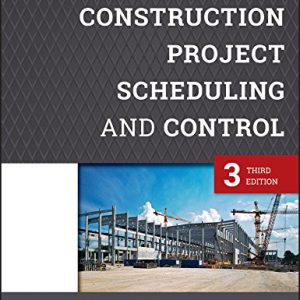
Product details:
- ISBN 10 : 1119104734
- ISBN 13 : 9781119104735
- Author: Mubarak, Saleh A.
bAn easy-to-follow guide to the theory and practice of project scheduling and control/bpNo matter how large or small the construction project, an efficient, well-thought-out schedule is crucial to achieving success. The schedule manages all aspects of a job, such as adjusting staff requirements at various stages, overseeing materials deliveries and equipment needs, organizing inspections, and estimating time needs for curing and settling#8212;all of which requires a deep understanding on the part of the scheduler.pWritten by a career construction professional, iConstruction Project Scheduling and Control/i, iSecond Edition/i has been fully revised with up-to-date coverage detailing all the steps needed to devise a technologically advanced schedule geared toward streamlining the construction process.
Table contents:
Chapter 1 Introduction 1
Planning and Scheduling 2
What is a Project? 2
Are Projects Unique? 4
Project Management Plan 7
Project Control 8
Why Schedule Projects? 8
The Scheduler 11
Certification 11
The Tripod of a Good Scheduling System 12
Scheduling and Project Management 12
Chapter 1 Exercises 13
Chapter 2 Bar (Gantt) Charts 15
Definition and Introduction 16
Advantages of Bar Charts 18
Disadvantages of Bar Charts 20
Chapter 2 Exercises 21
Chapter 3 Basic Networks 23
Definition and Introduction 24
Arrow Networks 24
Brief Explanation 24
The Logic 25
Notation 25
Dummy Activities 26
Redundancies 31
Node Networks 31
Lags and Leads 32
Recommendations for Proper Node Diagram Drawing 35
Comparison of Arrow and Node Networks 37
Networks versus Bar Charts 39
Effective Use of Bar Charts with CPM 40
Time-Scaled Logic Diagrams 40
Chapter 3 Exercises 41
Chapter 4 The Critical Path Method (CPM) 45
Introduction 46
Steps Required to Schedule a Project 47
Main Steps 47
Supplemental Steps 55
Resource Allocation and Leveling 57
Beginning-of-Day or End-of-Day Convention 59
The CPM Explained through Examples 59
Example 4.1: Logic Networks and the CPM 59
The CPM with Computer Software Programs 63
The Critical Path 64
Definitions 65
Examples 4.2 and 4.3: Node Diagrams and the CPM 66
Free Float 67
More Definitions 70
Float Check 71
Node Format 72
Lags and Leads in CPM Networks 73
Lags and Leads in Computer Software 76
Further Discussion of Float 76
Effect of Date Choices on Cash Flow 78
Project Schedule “Health Check” 78
Event Times in Arrow Networks 79
Effect of the Imposed Finish Date on the Schedule 81
Discussion of Example 4.7 82
Logic and Constraints 84
The “Hub” Concept 85
The Critical Path Method and Scheduling 85
Chapter 4 Exercises 86
Chapter 5 Precedence Networks 93
Definition and Introduction 94
The Four Types of Relationships 97
Important Comments about the Four Types of Relationships 98
The Percent Complete Approach 98
Fast-Track Projects 99
A Parallel Predecessor? 101
CPM Calculations for Precedence Diagrams 102
Interruptible Activities 102
The Simplistic Approach 105
Alternative Approach 107
The Detailed Approach 110
Contiguous (Uninterruptible) Activities 113
Remedy for Interruptible Activities 117
Multistage Activities 120
Types of Lags 121
Final Discussion 123
Chapter 5 Exercises 124
Chapter 6 Resource Allocation and Resource Leveling 129
Introduction 130
The Three Categories of Resources 130
Labor 130
Equipment and Materials 130
What is Resource Allocation? 131
Resource Leveling 131
What is Resource Leveling? 131
Why Level Resources? 131
Do All Resources Have to Be Leveled? 132
Multiproject Resource Leveling 132
Assigning Budgets in Computer Scheduling Programs 134
Leveling Resources in a Project 136
Resource Leveling from the General Contractor’s Perspective 153
Materials Management 155
Chapter 6 Exercises 159
Chapter 7 Schedule Updating and Project Control 163
Introduction 164
The Need for Schedule Updating 164
Project Control Defined 164
Schedule Updating 165
What is a Baseline Schedule? 165
What is an Updated Schedule? 167
What is the Data Date? 168
What Kind of Information is Needed for Updating Schedules? 168
Frequency of Updating 171
Retained Logic or Progress Override 172
Auto-Updating 172
Updating Schedules and Pay Requests 173
“Degressing” an In-Progress Schedule to Create a Baseline Schedule 175
Effect of Adding or Deleting Activities on Logic 176
Steps for Updating a Schedule 180
Change in the Critical Path 191
Float after the Update 191
Contractor-Created Float 192
Data and Information 193
Project Control 194
Measuring Work Progress 194
Earned Value Analysis 208
Chapter 7 Exercises 217
Chapter 8 Schedule Compression and Time-Cost Trade-Off 223
Introduction 224
How Important is It to Finish on Schedule? 225
Setting Priorities 225
Accelerating a Project 226
What is “Accelerating” a Project? 226
Why Accelerate a Project? 226
How Can Project Duration Be Shortened? 227
Acceleration and Fast-Tracking 235
Construction and Modularization 235
How Does Accelerating a Project Work? 236
Direct and Indirect Costs 238
Cost Concepts as They Relate to Schedule Compression 240
Choosing the Best Method for Project Acceleration 240
Effect of Acceleration on Direct Costs 241
Effect of Acceleration on Indirect Costs 242
Effect of Acceleration on Total Cost 243
Issues to Consider When Accelerating a Project 245
Recovery Schedules 247
Accelerating Projects Using Computers 252
Potential Issues with Uncoordinated Project Acceleration 253
Optimum Project Scheduling 254
Project Scheduling and Prevailing Economic Conditions 255
Project Scheduling in Extreme Weather Regions 256
Optimum Scheduling 256
Productivity and Cost Multipliers 258
Chapter 8 Exercises 260
Chapter 9 Reports and Presentations 265
Introduction 266
The Difference between Reports and Presentations 270
Skills Necessary for Giving Good Presentations 272
The Power of Presentations 273
Reviewing Reports before and after Printing 275
General Tips on Printing Reports 276
Summary Reports 277
Paper or Electronic Reports? 277
E-Reports 280
Communications in the International Environment 280
Chapter 9 Exercises 282
Chapter 10 Scheduling as Part of the Project Management Effort 285
Introduction 286
Project Objectives 287
Defining and Measuring Project Success 288
Scheduling and Estimating 290
Evolution of a Cost Estimate and a Schedule for a Project 291
Estimate-Generated Schedules 294
Cost-Loaded Schedules 296
Estimating and Accounting 296
Scheduling and Accounting 298
Scheduling and Change Orders 298
Paperless Project Management 299
Procurement Management 300
Management of Submittals 301
The Master Schedule and Subschedules 303
Multiproject Management 304
Time Contingency and Management Options 305
Chapter 10 Exercises 308
Chapter 11 Other Scheduling Methods 311
Introduction 312
Program Evaluation and Review Technique (PERT) 312
Background 312
Concept of PERT 312
How PERT Works 313
PERT Calculations 313
Graphic Explanation 316
“Most Likely” versus “Expected” Durations 323
Is the Longest Path Still the Most Critical? 323
Using PERT to Calculate the Date of an Event with a Certain Level of Confidence 326
Determining the Probability of a Certain Project Finish Date (Multiple Paths Considered) 327
PERT and the Construction Industry 328
PERT and Computer Project-Scheduling Software 328
Graphical Evaluation and Review Technique (GERT) 329
Linear Scheduling Method (LSM) 330
Steps to Build a Schedule Using the LSM 331
How the LSM Works 331
LSM and Project Schedule Acceleration 337
LSM Computer Software Programs 337
Graphical Path Method (GPM) 338
Relationship Diagramming Method (RDM) 342
The Critical Path Segments (CPS) Scheduling Technique 346
Chapter 11 Exercises 348
Chapter 12 Dynamic Minimum Lag Relationship 353
Introduction 354
Why DML? 354
Similarity between the DML Concept and the Linear Scheduling Method (LSM) 355
How Does DML Work? 356
DML Relationship in CPM Calculations 358
Can the Lag in the DML Relationship Be a Percentage? 359
Conclusion 365
Chapter 12 Exercises 366
Chapter 13 The Critical Path Definition: Revisited 367
Introduction 367
What is the “Longest Path”? 368
The Critical Path through Examples 369
The Simple Case 369
Imposed Finish Date 370
Activities with Lags 370
Activities with Constraints 371
Activities with Different Calendars 373
Precedence Diagrams 373
Further Discussion of Example 7 375
Resource Constraints 377
Resource Allocation and Resource Leveling 378
Risk and Probabilistic Durations 379
Risk, Consequences, or Both? 379
The AACE Recommended Practices No. 49R-06 and 92R-17 381
Proposed Definition of the Critical Path 381
Changes in the Critical Path 382
Chapter 14 Construction Delays and Other Claims 383
Introduction 384
Delay Claims 384
Reasons for Claims 386
Force Majeure 388
Types of Delays 389
Scheduling Mistakes Related to Delay Claims 390
Project Documentation 393
Delay Claims Resolution 396
The Importance of CPM Schedules in Delay Claims 399
Methods of Schedule Analysis 399
As-built Schedule 400
Updated Impact Schedule 400
As-Planned Schedule 400
Comparison Schedule 400
Accelerated Schedule 400
Who Owns the Float 401
Chapter 14 Exercises 406
Chapter 15 Schedule Risk Management 409
Introduction 410
Types of Risk in Construction Projects 411
Schedule Risk Types 412
General Duration Uncertainty 414
Specific Risk Events 416
Network Logic Risks 417
Definition of Risk Terms 418
Importance of Good Planning for Risk Management 420
Importance of Good CPM Scheduling Practices for Risk Assessment 420
Risk Shifting in Contracts 422
Schedule Risk Management Steps 424
1. Risk Management Planning 425
2. Identifying Schedule Risks 427
3. Performing Qualitative Analysis 427
4. Performing Risk Prioritization for the Qualitative Analysis (Quantitative Analysis) 429
5. Responding to and Addressing Risks 429
6. Monitoring and Updating the Risk Management Plan 430
Expected Value 430
Application in Scheduling 432
Examples of Risk Adjustment 433
Conclusion 434
Chapter 15 Exercises 435
Chapter 16 BIM-Based 4D Modeling and Scheduling 437
Overview of Building Information Modeling (BIM) 437
Definition and Benefits of BIM 437
Differences between BIM and CAD 438
Definition and Benefits of 3D Modeling 440
Definition and Benefits of 4D Modeling 441
Steps for Creating 4D Models 442
Definition and Benefits of 5D Modeling 443
Case Study 445
Project Information 445
Creating and Linking the 3D Model 445
Information about the TimeLiner Tab 446
Creating and Importing Project Schedules 447
Defining Task Types 451
Creating Selection Sets 453
Creating the 4D Model and Project Animation 453
Exporting Snapshots and Animation 457
Using Integrated Systems 461
Lean Construction 462
Chapter 16 Exercises 464
Chapter 17 Project Scheduling for Owners 467
Introduction 467
Project Initiation Process 468
The Owner’s Organization 471
Project Planning 471
Using Available Tools 473
Best Value 473
The Evolution of the Schedule 474
Choosing the Contract Type and Delivery Method 475
Contract Templates 476
Owner-Contractor Trust Relationship 477
Project Financing 477
Requiring and Approving a Schedule 478
Owning and Managing Float 479
Managing the Contractor 480
Managing Scope/Changes 480
Schedule Updating and Percent Complete 482
Delay Claims: Avoidance and Resolution 482
Chapter 17 Exercises 483
Title Tag:
Essential Guide to Construction Project Scheduling and Control
Mastering the Art of Construction Project Scheduling and Control
An Insight into Effective Construction Project Scheduling and Control
You may also like…
Business & Economics - Project Management


